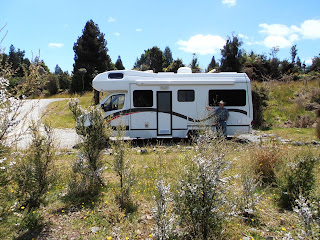 |
| The old Awatere River bridge |
The
next morning, we left without regret; it was time to move on. We stopped at
Hokitika to fill up with diesel and refill the gas bottle that had run out on
Boxing Day, then headed north again back toward Kumara Junction. We did stop on
the southern bank of the Awatere River where a portion of the old Howard Truss
bridge has been installed as a memorial, in the same fashion as that crossing
the Waitaki River at Kurow.
This
one was originally built as a rail bridge, later converted to serve road
traffic as well. That was in 1891 and it served well right through to 2009 when
it was replaced with a two lane road bridge and a separate rail lane. The name
“Howard Truss” is named for William Howe whose design in 1840 incorporatated
iron into a timber structure. He obviously knew his stuff and it would seem
that his bridges, or those constructed to his design, will prove to have
greater longevity than their more modern replacements.
 |
| Swingbridge over Woods Creek |
Not too far north of this, after following the coast,
we turned east toward the tourist attraction Shantytown where one can
experience life in a pseudo-1860 gold field settlement. We continued on up the
road for another seventeen kilometres, the road now gravel but wide, no doubt
to accomodate the mining traffic still working in the area although apparently not
over the holiday period. We passed great swathes of upturned gravel, piles of
slag but none of this explaining what kind of mining is being undertaken in
these modern times. We could only guess that it was a review and reworking of
the gold extraction carried out here in the 1860s.
 |
| Swingbridge exit above creek |
There are tunnel entrances, tail races barely narrow
enough to fit a slim hipped Asian miner and dams. The creeks are crossed with
bridges, the steep slopes scaled and descended on sturdy stairs that would not
have existed in the past as they do today. The path winds its way through regenerating
kamihi, quintinia, rimu, kahikatea and totara; an easy path lined with soft
moss, the sort of “fairy” path my sisters and I used to make through the bush
behind our house when we were so very small. The last bridge is a high strung
swingbridge seeming to have very little holding it attached to the opposing
walls, appearing to terminate at the face of an eroded bank. But on reaching
the end, one turns sharp right and climbs up through one of those narrow and
deep tunnels, quite unsuitable for the well-fed matrons of today to pass
through.
 |
| Our unofficial camping spot |
While we passed the afternoon reading between listening
and watching the finches, tomtits and tuis and a curious weka dart hither and
thither, we noted the surprising number of tourists who had also come to walk.
Obviously this obscure walk is not so obscure these days after all.
A large rental motorhome came in and parked tightly in
beside us; a family of four stepped out and set off to do the walk, all good so
far. But on their return they asked if we intended to stay on overnight. When
we told them we were, they said they were too; it was allowed?
 |
| Weka |
In fact I suspect we were shopping in the supermarket
at Greymouth before they even breakfasted, or maybe stacking and storing our
purchases all away? We parked up on the northern bank of the Grey River, a spot
we have stayed at on several previous occasions. The sun was shining, the
morning misty rain had cleared away and we set off on foot back across the
river to the town just as the Trans-Alpine train arrived from Christchurch.
Tourists poured out, clogging the booking office at the station, seeking and
sorting rental cars and accomodation. We picked our way around their luggage to
find ourselves a street map then set off downtown to find a few bits we needed.
 |
| Coalminers memorial |
 |
| Greymouth and the Grey River |
The floods and mining disasters that followed were all
part of West Coast life. Much more recently there were devastating floods again,
in May and September 1988, and it was these two in quick succession that
prompted the building of the existing flood wall in the following year.
Part way along this wall is a wonderful memorial “In memory of those lost in coal mining
incidents within the West Coast Inspection District”, unveiled by the Mayor
Tony Kokshoorn in 2013 on the anniversary of the 1967 Strongman Mine disaster.
More poignantly, it was unveiled on 19 November, the second anniversary of the
Pike River disaster that claimed the lives of twenty nine men. (I make specific
mention of the mayor by name, because he has become quite famous here in New
Zealand as the spokesman for the community who today are protesting about the
sealing up of the Pike River mine without having “rescued” their now long dead
relatives.)
 |
| Our camp above the Grey River |
Back at camp, we picked up emails and caught up with
other matters that rely on internet reception, something we have managed without
since leaving Christchurch, sometimes because of our location and sometimes because
I have preferred to spend the time with my other half.
As I write this, the sun is low in the sky and the shadows
are long upon the high cliff that rises above the river. Fellow campers are out
and about socialising with this one and that, but we remain tucked up out of
the wind, planning our tomorrows and recording our yesterdays.
No comments:
Post a Comment